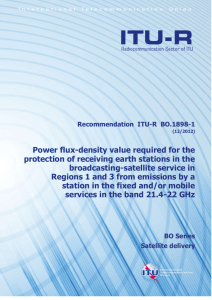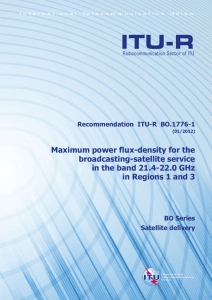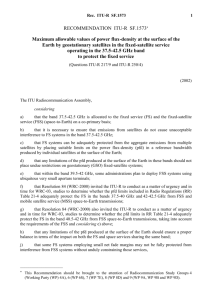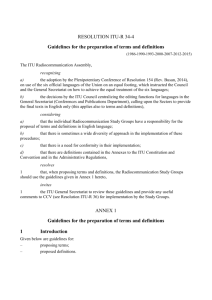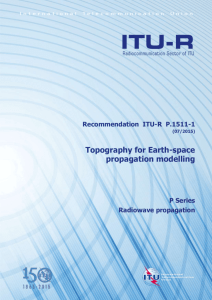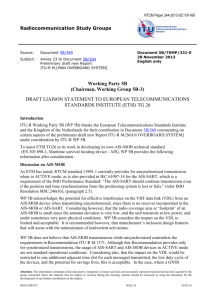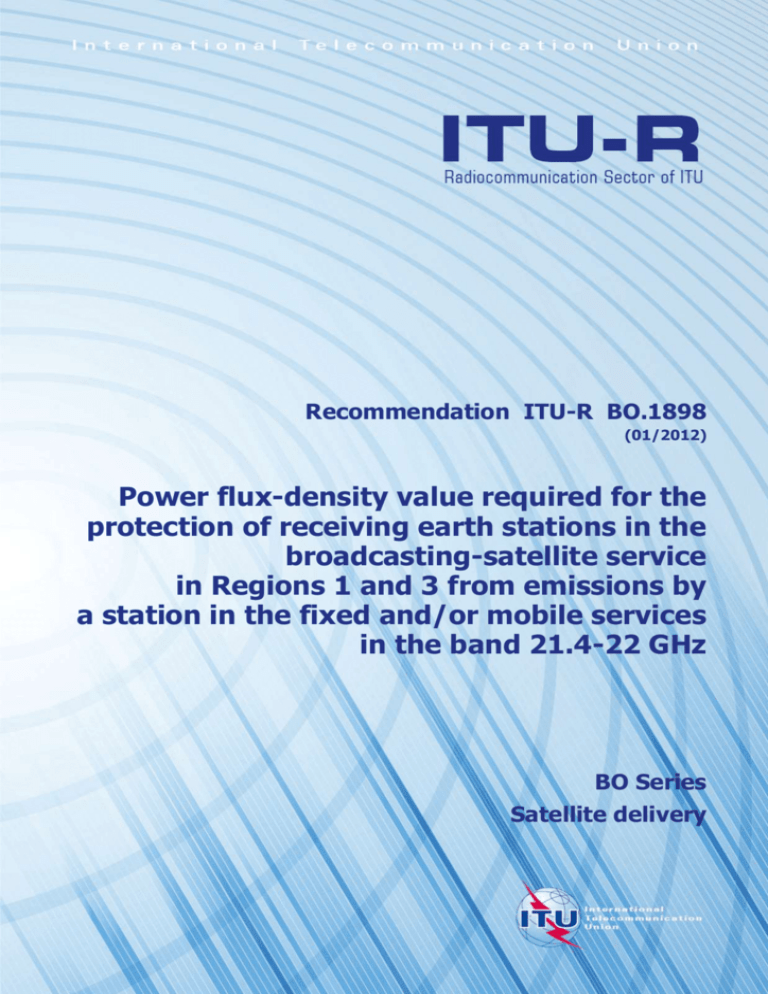
Recommendation ITU-R BO.1898
(01/2012)
Power flux-density value required for the
protection of receiving earth stations in the
broadcasting-satellite service
in Regions 1 and 3 from emissions by
a station in the fixed and/or mobile services
in the band 21.4-22 GHz
BO Series
Satellite delivery
ii
Rec. ITU-R BO.1898
Foreword
The role of the Radiocommunication Sector is to ensure the rational, equitable, efficient and economical use of the
radio-frequency spectrum by all radiocommunication services, including satellite services, and carry out studies without
limit of frequency range on the basis of which Recommendations are adopted.
The regulatory and policy functions of the Radiocommunication Sector are performed by World and Regional
Radiocommunication Conferences and Radiocommunication Assemblies supported by Study Groups.
Policy on Intellectual Property Right (IPR)
ITU-R policy on IPR is described in the Common Patent Policy for ITU-T/ITU-R/ISO/IEC referenced in Annex 1 of
Resolution ITU-R 1. Forms to be used for the submission of patent statements and licensing declarations by patent
holders are available from http://www.itu.int/ITU-R/go/patents/en where the Guidelines for Implementation of the
Common Patent Policy for ITU-T/ITU-R/ISO/IEC and the ITU-R patent information database can also be found.
Series of ITU-R Recommendations
(Also available online at http://www.itu.int/publ/R-REC/en)
Series
BO
BR
BS
BT
F
M
P
RA
RS
S
SA
SF
SM
SNG
TF
V
Title
Satellite delivery
Recording for production, archival and play-out; film for television
Broadcasting service (sound)
Broadcasting service (television)
Fixed service
Mobile, radiodetermination, amateur and related satellite services
Radiowave propagation
Radio astronomy
Remote sensing systems
Fixed-satellite service
Space applications and meteorology
Frequency sharing and coordination between fixed-satellite and fixed service systems
Spectrum management
Satellite news gathering
Time signals and frequency standards emissions
Vocabulary and related subjects
Note: This ITU-R Recommendation was approved in English under the procedure detailed in Resolution ITU-R 1.
Electronic Publication
Geneva, 2012
ITU 2012
All rights reserved. No part of this publication may be reproduced, by any means whatsoever, without written permission of ITU.
Rec. ITU-R BO.1898
1
RECOMMENDATION ITU-R BO.1898
Power flux-density value required for the protection of receiving earth stations
in the broadcasting-satellite service in Regions 1 and 3 from emissions by a
station in the fixed and/or mobile services in the band 21.4-22 GHz
(2012)
Scope
This Recommendation provides the maximum permissible pfd value to protect receiving earth stations in the
BSS in Regions 1 and 3 from emissions generated by a single station in the fixed and/or mobile services in
the band 21.4-22.0 GHz. It is intended to be used as guidance to administrations in their bilateral or
multilateral negotiations by providing the detailed methodology and the derived pfd value.
The ITU Radiocommunication Assembly,
considering
a)
that emissions from terrestrial stations may produce interference exceeding permissible
levels into receiving earth stations in the BSS in Regions 1 and 3 in the band 21.4-22.0 GHz;
b)
that in order to protect BSS receiving earth stations in Regions 1 and 3 from unacceptable
interference of terrestrial stations, an appropriate maximum permissible pfd value applicable to
emissions from a terrestrial station in this band needs to be determined,
recommends
1
that, in order to protect BSS receiving earth stations, a value of –120.4 dB(W/(m2·1 MHz))
should be used as the single-entry maximum permissible level of the pfd produced by emissions
from a terrestrial station in the band 21.4-22.0 GHz;
2
that this value should not be exceeded at 3 m above the ground at any point of the territory
of any other administrations in Regions 1 and 3 for more than 20% of the time, calculated in
accordance with Recommendation ITU-R P.452-14;
3
that the following Notes should be considered as part of this Recommendation.
NOTE 1 – The pfd value in recommends 1 was derived using the methodology contained in
Annex 1.
NOTE 2 – The single entry pfd in recommends 1 is derived from an aggregate I/N = –12.2 dB
(corresponding to a 6% increase of the equivalent system noise temperature), assuming
an equivalent number of 3.3 interfering sources, each transmitting at maximum single entry pfd.
NOTE 3 – The value in recommends 1 is derived under the assumption that the minimum angle
between the direction of maximum antenna gain of the BSS earth station and the direction to the
interfering transmitter is 10 degrees.
NOTE 4 – The value in recommends 1 may be used either as a hard limit or a threshold value to
ensure protection of the broadcasting-satellite network in Regions 1 and 3 from a terrestrial station,
as appropriate.
2
Rec. ITU-R BO.1898
Annex 1
Methodology and assumptions to calculate the maximum permissible power
flux-density value required for the protection of the BSS receiving earth
stations in Regions 1 and 3, from emissions by a terrestrial station
in the band 21.4-22.0 GHz
In order to protect the BSS receiving earth station, the maximum permissible power flux-density
(pfd) value produced by emissions from a terrestrial station in the band 21.4-22.0 GHz is given by
the equation:
PFDn Pn ( I / N ) S (min )
(1)
where:
PFDn:
Pn = kT × (106):
S(φmin):
maximum permissible pfd value for a single terrestrial
(dB(W/(m2·1 MHz)));
BSS receiving earth station noise power (dB(W/1 MHz));
BSS receiving earth station antenna-effective area (dBm2).
station
The total BSS receiving earth station noise temperature (including antenna noise) is assumed as
140 K. Therefore, the noise power, Pn, for the BSS receiving station is calculated as follows;
Pn = –228.6 + 10 log(140) + 10 log(106) = –147.1 dB(W/1 MHz)
(2)
The permissible I/N ratio from a single terrestrial station is assumed as –17.4 dB1.
S(φmin) is defined by the following equation:
S (min ) G(min ) 10 log (2 / 4)
(3)
where G(φmin) is BSS receiving earth station antenna gain in the direction φmin from the axis of the
main beam and in a corresponding range of φmin values, the antenna gain is equal to:
G(min ) 29 25 log (min ) 4 dBi
(4)
where the minimum angle between the direction of maximum antenna gain of the BSS earth station
and the direction to the interfering transmitter, φmin, for the broadcasting-satellite network in the
band 21.4-22.0 GHz is assumed as 10 degrees.
Then, S(φmin) = –44.2 dBm2 (at 21.7 GHz).
Using these values above and equation (1), the maximum permissible single entry PFDn is
calculated to be:
PFDn = –120.4 dB(W/(m2 · 1 MHz))
_______________
1
The single entry pfd is derived from an aggregate I/N = –12.2 dB (corresponding to a 6% increase of the
equivalent system noise temperature), assuming an equivalent number of 3.3 interfering sources, each
transmitting at maximum single entry pfd.

